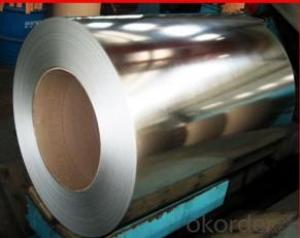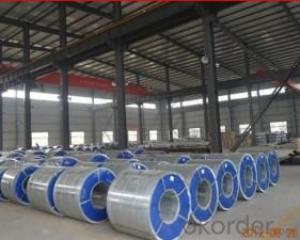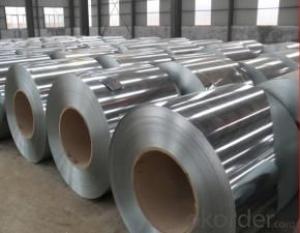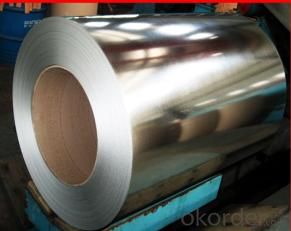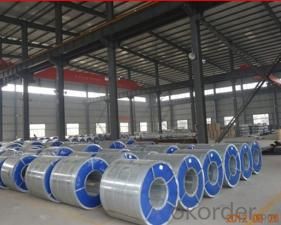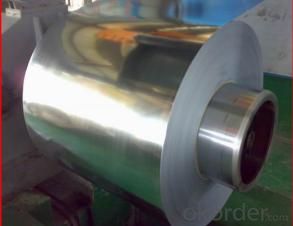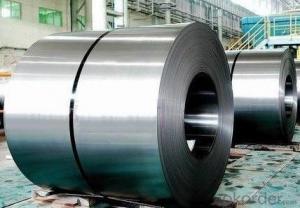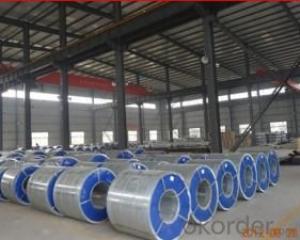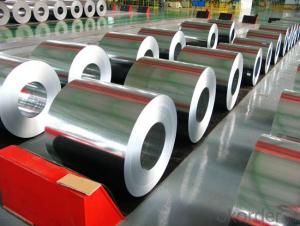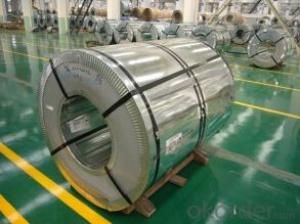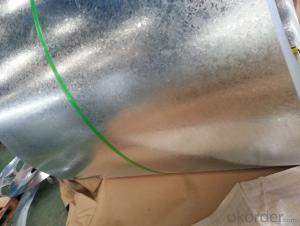Hot Dipped Galvanized Steel Coils for Steel Structure buildings
- Loading Port:
- Shanghai
- Payment Terms:
- TT OR LC
- Min Order Qty:
- 30 m.t.
- Supply Capability:
- 10000 m.t./month
OKorder Service Pledge
OKorder Financial Service
You Might Also Like
Basic Info.
Model NO.:Hot Dipped Galvanized Steel Coil
Surface Treatment:Galvanized
Certification:ISO, SGS, BV, RoHS, IBR
Technique:Cold Rolled
Standard:ASTM, JIS, GB, AISI, DIN, BS
Application:Roofing, Wall, Corrugated, Structure...
Edge:Mill
Stock:Stock
Steel Grade:Dx51d, SPCC, SGCC, CGCC, S350gd
Name:Hot Dipped Galvanized Steel Coil
Thickness:0.14-1.2mm
Width:600-1250mm
Surface:Oiled, Galvanized, Chromated
Zn Coating:40-275GSM
Spangle:Zero, Small, Big, Regular
Coil Weight:3-10tons
Coil ID:508/610mm
Certificate:BV, ISO
Test:QA-QC-Mtc
Export Markets:Global
Additional Info.
Packing:Standard Export Package
Standard:0.14-1.2mm*762-1250mm
HS Code:7905000000
Production Capacity:30000 Tons/Year
Product Description
1. Galvanized steel coil simple introduction:
Galvanized steel coil means that steel coils has gone through a chemical process
To keep it from corroding, so this protective metal, zinc layers, does not get rusty as easily. The coating also gives the steel a more durable, hard to scratch finish.
(1)Thickness:0.14-1.2mm
(2)Width:600-1250mm
(3)Material:SGCC,DX51D,S350GD,SPCC,CGCC
(4)Zn:40-275gsm
(5)Surface:oiled,chromated
(6)Application: Corrugated,Wall,Roofing,Structure and so on
2. Galvanized steel coil technical processing:
1)Uncoiled and sheared
2)Cleaned using a caustic solution, which can remove oil/grease, dirt, and paint
3)Entry looper to revised and then annealing furnace
4)Steel is dipped into the molten zinc bath
5)Cooled in a quench tank to reduce its temperature
6)Post treatment and crimper
3. Galvanized steel coil quality control:
Strict procurement process---skillful technical workers---final products inspection
(resistance to corrosion, salt spray test, exposure test, machinability, thermal resistance)
---standard packing
4. Galvanized steel coil advantages:
1)Zinc coating has good adhesion
2)Resistant to corrosive factors
3)High strength&quality
4)Strict quality control system
5)Standard export sea-worthy packing
5. Why choose us?
1).Advantages: We have two production line of PPGI and two lines for the galvanized steel coil, total yearly output is about 500000mt Also we have 56 professional salesperson from three international sales department, a group of technical engineers
And skillful quality control inspector.
2). Special technology support: We have two production line of pre-painted steel coil
And two lines for the galvanized steel coil, total yearly output is about 500000mt. In
Order to meet our customers new requirements, We also can manufacture the special
Products, such as Printed, Filmed, Pressed, Matte steel coil and the full hard G550
Galvanized steel and galvalume steel.
3). Conform the international quality standard: All products for export, according to the
International quality standard of Europe, Japan, Russia and America to produce.
- Q: Just wondering how good are forge steel screw drivers, tool boxes(organisers) and pliers are, as screw fix are having a january sale, and looking to add to my tool collection. Thanks in advance
- Go craftsman not bad prices and lifetime warranty.
- Q: describe the benifits and disadvantages of the using steel as a material for fasteners
- There are different grades of steels which can suit different application considering corrosion,surrounding atmosphere,pressure,temperature and many more. Let us take the stainless steel fasteners: 1.Resists Rust: The primary advantage to using stainless steel bolts is that they resist rusting. This makes them ideal for outdoor or marine uses, since moisture will not cause them to corrode. Rust basically eats steel and makes it weaker. A rusty, weak bolt can be a serious safety risk, because it can break under a load. 2.Clean: Stainless steel bolts are very easy to clean due to having a higher content of chromium, which creates a lustrous, mirror-like surface that is very smooth. This makes stainless steel an ideal option if aesthetics are an issue. 3.Temperature: Stainless steel has a high melting point, which makes it a good option in machines that are put through immense amounts of heat. The bolts will not fuse together, and can be unfastened when the machines need repairs. Also, in very cold conditions, steel can become brittle. By mixing nickel into the stainless steel, the metal resists becoming brittle at low temperatures. See the source link for details.
- Q: What are the different methods of slitting steel coils?
- Different methods exist for slitting steel coils, each with unique advantages and limitations. Several common methods include: 1. Rotary Shear Slitting: By employing rotating knives, this method cuts steel coils into narrower strips. It is versatile and efficient, enabling high-speed production and precise slitting. Rotary shear slitting is commonly utilized for thinner gauge materials. 2. Looping Pit Slitting: Steel coils pass through a looping pit in this method, where they are guided and tensioned before being slit. It is suitable for thicker gauge materials and ensures good edge quality. Looping pit slitting accommodates higher coil speeds and heavier coils. 3. Drag Slitting: In this method, the steel coil is dragged over a stationary blade or set of blades to perform the slitting. It is particularly beneficial for difficult-to-slit materials like high-strength steels. Drag slitting yields excellent edge quality and is often utilized for precision slitting applications. 4. Crush Slitting: Pressure is applied to the steel coil in crush slitting to crush and separate it into narrower strips. This cost-effective method is suitable for lower gauge materials but may result in slightly rougher edge quality compared to other methods. 5. Laser Slitting: Laser slitting employs a focused laser beam to cut through the steel coil. It is a highly precise method that offers excellent edge quality and minimal distortion. Laser slitting is commonly employed for high-value and specialty materials. Each method possesses distinct advantages and is suitable for specific applications and material types. The choice of slitting method depends on factors such as material thickness, desired edge quality, production speed requirements, and budget considerations.
- Q: What are the different types of steel coil storage systems used during processing?
- There are several types of steel coil storage systems commonly used during processing, including coil racks, coil saddles, coil cradles, coil pads, and coil blocks. These systems are designed to safely store and handle steel coils, ensuring efficient processing operations and minimizing the risk of damage or accidents.
- Q: How are steel coils cut into smaller sizes?
- To achieve smaller sizes for steel coils, there are diverse methods available, which depend on the desired dimensions and quantities. One widely used technique is slitting, where the coil is passed through a set of circular blades that simultaneously make multiple cuts, resulting in narrower steel strips. Slitting is commonly employed to produce narrow coils or strips tailored for specific applications like automotive parts or electrical components. Another option is shearing, which entails cutting the coil into smaller lengths using a straight blade. This method is typically chosen when precise dimensions are necessary, such as in the manufacturing of flat sheets or plates. Shearing can be carried out manually or with automated machinery. Furthermore, laser or plasma cutting techniques can be employed for certain types of steel coils. These methods offer greater flexibility in terms of shape and size, enabling intricate cuts or contours to be created. Laser or plasma cutting is frequently utilized in construction or fabrication projects when specific shapes or profiles are required. In summary, cutting steel coils into smaller sizes involves a range of techniques, including slitting, shearing, laser cutting, or plasma cutting. The selection of the method depends on factors such as the desired dimensions, quantities, and specific requirements of the end product.
- Q: Can steel coils be coated with fire-resistant materials?
- Yes, steel coils can be coated with fire-resistant materials.
- Q: How are steel coils used in the production of metal shelving?
- Steel coils are used in the production of metal shelving by being processed and formed into the desired shape and size. The coils are unwound and then either cut or shaped using various techniques such as bending, welding, and punching. This allows for the creation of sturdy and durable shelves that can hold heavy loads.
- Q: How are steel coils used in the production of telecommunications equipment?
- The production of telecommunications equipment commonly involves the use of steel coils, which offer structural support and durability. These coils are utilized to fabricate different components, including cabinets, racks, and enclosures. A significant application of steel coils in telecommunications equipment is seen in the manufacturing of cabinets. These cabinets serve as housing for the delicate electronic components and wiring utilized in telecommunications systems. Steel coils are typically shaped to form the cabinet structure, providing a robust and dependable enclosure for the equipment. The steel material also offers protection against external factors such as impacts, dust, and moisture, ensuring the longevity and integrity of the telecommunications equipment. Steel coils also find application in the production of racks for telecommunications equipment. These racks are designed to organize and provide accessibility to multiple devices, including servers, switches, and routers. The strength and rigidity of steel coils make them an ideal material for constructing these racks, ensuring they can bear the weight of multiple devices and withstand the constant handling and movement that occur in telecommunication environments. Moreover, steel coils are used to manufacture enclosures for telecommunications equipment. These enclosures act as protective casings, safeguarding sensitive electronic components from external influences such as electromagnetic interference and physical damage. Steel coils are often formed into specific shapes and sizes to create these enclosures, providing a sturdy barrier that shields the equipment from various external threats. In conclusion, steel coils play a crucial role in the production of telecommunications equipment by offering structural support, durability, and protection. They are employed in the creation of cabinets, racks, and enclosures, which ensure the proper functioning and longevity of the sensitive electronic components used in telecommunication systems.
- Q: How are steel coils used in the production of roofing panels?
- To manufacture roofing panels, steel coils are indispensable. These coils, usually composed of galvanized or coated steel, serve as the fundamental material for producing robust and top-notch roofing panels. Initially, the steel coils undergo a sequence of operations in a production facility. These operations involve flattening, cleaning, and shaping the coils to achieve the desired dimensions and profiles for the roofing panels. This process guarantees that the steel coils possess uniform thickness and are devoid of any impurities or flaws that could compromise the final product's integrity. Once the steel coils are prepared, they are fed into a roll forming machine. In this machine, the coils are gradually bent and shaped into the specific design and size required for the roofing panels. The roll forming process imparts the panels with their distinct corrugated or standing seam profiles, which enhance their strength and ability to withstand various weather conditions. After the roll forming process, the steel coils are divided into individual roofing panels of the desired length. These panels then undergo further processing to incorporate additional features, such as coatings or finishes, to enhance protection against corrosion and improve aesthetic appeal. Protective layers, such as zinc or paint, are often applied to the steel coils to enhance their resistance to rust, UV rays, and other environmental factors. Lastly, the roofing panels are packaged and transported to construction sites or distributors for installation. The utilization of steel coils in the production of roofing panels ensures that the final product is sturdy, long-lasting, and capable of withstanding heavy loads, strong winds, and other external forces. Steel is renowned for its high tensile strength, making it an ideal material for creating durable roofing panels. In conclusion, steel coils play a vital role in the production of roofing panels. Through a series of manufacturing processes, they are transformed into the desired dimensions and profiles, ensuring consistency and quality. The resulting roofing panels are not only visually pleasing but also highly resilient, providing superior protection and longevity for buildings.
- Q: Question about steel type used in bridges.?
- It is used for other things besides bridges and that might be a bad use. Corten was used for very tall light standards in the Fort Worth Water Gardens with the clear understanding that it was to be kept dry. As time passed and personnel changed, somebody decided the round base with bolts sticking up was ugly and put dirt and plantings in the basin in the concrete holding the poles. The watering of the plants kept the rust going through the steel and one pole eventually fell, killing two people. The other light poles were removed.
Send your message to us
Hot Dipped Galvanized Steel Coils for Steel Structure buildings
- Loading Port:
- Shanghai
- Payment Terms:
- TT OR LC
- Min Order Qty:
- 30 m.t.
- Supply Capability:
- 10000 m.t./month
OKorder Service Pledge
OKorder Financial Service
Similar products
Hot products
Hot Searches
Related keywords
